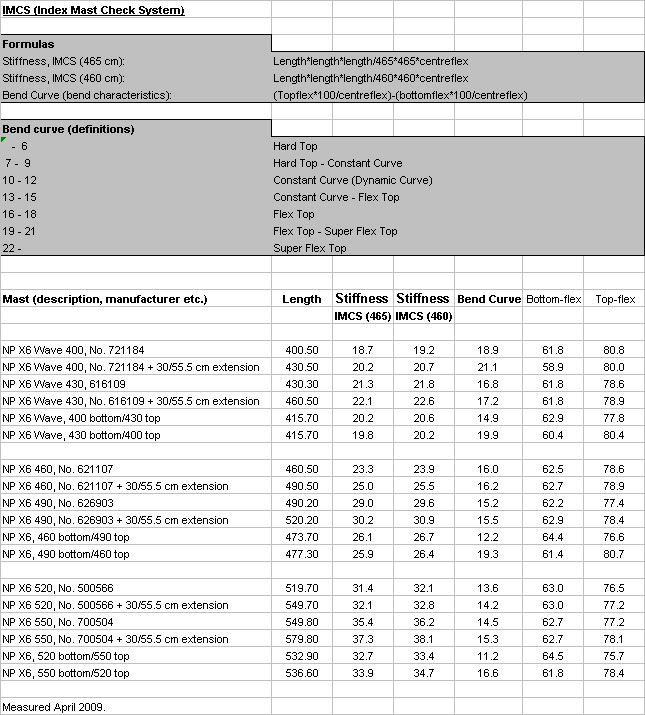|
The "LEGO-mast". A Neil Pryde X6 mast study.
The mission here is not to give a general judgment of the Neil Pryde X6 masts - but just to get over this point, here's a very incomplete line up of pros and cons of the X6 masts:
Generally speaking Neil Pryde masts - at least the better/more expensive series - are characterized by having the relatively softest tops among the masts available in the windsurf industry. And in this respect the X6 mast is certainly no exception, as in fact it's the most selling Flex Top mast series by Neil Pryde. So yes, the X6 masts are useable with sails from some other brands, but pretty often it's not a happy marriage.
The aspect of the X6 mast, that will be examined closer here, is a feature, that I've not seen Neil Pryde praising it for (curiously so, seeing as the Neil Pryde guys seldom economize with words when it comes to praising their products):
This potentially makes the X6 mast a very versatile mast (i.e. if you have a ferrule fitting pair of X6 masts): - You're not completely lost, if one of your X6 masts breaks, as you have the option to more or less substitute the broken part; perhaps not ideal, but certainly useful ... - You have the option to experiment with stiffness and bend curve (also pretty relevant if you happens to own sails from other brands than Neil Pryde) ... - You have the option to "build" a mast with a length in between the normal 30 cm increments.
All right - 6 X6 masts have been through the usual IMCS mast bending test, and besides measuring the masts as "created", the masts have been matched in pairs along the mentioned guidelines - giving 4 combinations out of every pair of masts. And now, when the whole X6 series was present, the possibility of comparing the masts with the next shorter mast in the row with a 30 cm extension proved irresistible - so even if it falls a little outside the aim of this session, this issue was examined in the same turn.
Below you see a copy of an Excel sheet with the most relevant results from this measuring session. If you want to relate the results to other masts, here's a data base for a whole bunch of other masts.
|
|
|
|
Admittedly - this might be a little overwhelming, so let's split up the results in slightly more digestible portions:
Go to the X6 400 cm/X6 430 cm pair.
Go to the X6 460 cm/X6 490 cm pair.
Go to the X6 520 cm/X6 550 cm pair.
Go to the comparisons between the smaller X6 mast with 30 cm extension and the next X6 mast in the row.
|
|
Conclusion.
The aim with this little measuring session has been to find out, if the cross-fitting ability of the X6 series add some versatility to the mast series. And the conclusion is yes, the match-in-pairs potentially can be very useful and allows us to combine masts with stiffness in between the parent masts, and (most importantly) allows us to combine masts with either more or less bend curve than the parent masts.
Now, because the Neil Pryde X6 mast series is placed in one end of the bend curve scale (with soft tops), this means that there are limits to the otherwise great potential of the masts, as one of the options (bottom from the longer mast/top from the shorter mast) generally grows way too Flex Top for all other sails but Neil Pryde. The other option (bottom from the shorter mast/top from the longer mast) has a great chance of covering the needs of sails from other companies.
In contrast Maui Sails' best mast series define the other end of the bend curve scale (with stiff tops), and if we imagine Maui Sails building masts with the cross-fit ability (haven't tested Maui Sails' masts for this feature, so don't know if they do in fact have it), we shall probably have the same kind of limitation of potential: The combination of the bottom from the longer mast and the top from the shorter mast would probably be fine for sails from other companies, while the combination of the bottom from the shorter mast and the top from the longer mast would probably be too Hard Top for any sail.
But what if some of the more middle-of-the-road (bend curve wise) companies as for instance North, Gaastra, Severne, Gun etc. gave their best mast series the cross-fit feature? Then we're talking! Buying a pair of masts from these companies you should then have a fair chance of coming pretty close to the mast characteristics you want (including Neil Pryde and Maui Sails) - and now you could probably change sail brand without having to invest in new masts.
So, now we're just waiting for other mast producing companies to copy the X6 and build masts with ferule dimensions to cover two (or more!) lengths of their masts - and for the same companies to present some easy-to-understand diagrams telling the users/customers how to mix the mast parts to obtain certain mast characteristics. Not realistic?
|



